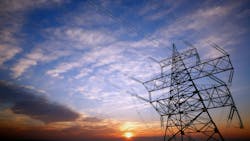The Perfect Storm Threatening the Electric Grid
"A perfect storm" is brewing on the electric grids around the world. Much like the 1991 perfect storm nor’easter, various elements are dangerously swirling. If these elements all align, it will result in a catastrophe. That happened to the crew of the Andrea Gail featured in a 1977 book by Sebastian Junger. It later became a summer blockbuster movie in 2000. Our industry’s perfect storm could cause a similar catastrophe to our power grids.
The foundational component of our storm is the grid’s aging infrastructure. Many grid components are beyond their expected lifespan. Most grid infrastructure entities do inspections and maintenance, but many wood poles are still decaying. We have rusting steel poles and towers. Cross-arms and hardware are fatiguing, conductors are wearing, and other unseen issues.
The next element is that most of our existing overhead power lines do not meet today’s standards. The National Electrical Safety Code (NESC) has existed since 1917, but as it says in Section 1, Rule 010.C, the NESC is not a design code, ”This Code is not intended as a design specification or as an instruction manual, nor is it intended to provide design criteria for abnormal events such as, but not limited to, actions of others or weather events in excess of those specified herein.” Simply meeting the NESC then or now does not mean that our grids are reliable. We must design our new and replaced overhead transmission and distribution power lines for expected weather events and follow modern engineering design practices.
A significant element adding to this already brewing storm is the increased demand for electricity due to systemic growth. Additional demand for electric vehicles (EVs) and a rise in data centers with AI advancements will further exacerbate the issue.
Public demand plus local, state, and federal mandates are resulting in the shift from fossil fuels to renewable energy generation. Unfortunately, the best wind and solar generation locations are far from the fossil fuel plants they intend to replace. America’s existing grids must be upgraded and new transmission lines must be built to adequately transfer these often remote energy generation facilities to the demand centers.
Unfortunately, the best wind and solar generation locations are far from the fossil fuel plants they intend to replace.
While these mandates are fueling the storm, significant permitting issues are blocking these new transmission lines from being built in a reasonable timeframe to meet these mandates. Ironically, many of the same people, governmental legislatures, and agencies who are mandating renewable energy often oppose permitting the very solution needed to implement the change.
Finally, the element of climate change must be addressed. However, I like to think of this element as how the public now expects a more reliable electric grid than they have expected or previously experienced. This expectation element is getting stronger as outages from natural events are more accentuated.
These six elements combined are the perfect storm which requires us to essentially rewire America (or whatever grid you are part of) if we are to survive this coming storm. Unfortunately, we are already in the middle of the coming storm.
The American Society of Civil Engineers (ASCE) provides the leadership to navigate the storm. The Overhead Power Line Structures (OPS) division of the Structural Engineering Institute (SEI) publishes and is currently updating many manuals of practices and standards, which are not minimum safety standards. ASCE focuses on the proper design of lattice steel towers, tubular steel poles, wood pole structures, and FRP pole structures. ASCE also focuses on the loading side of the equation with how wind, ice, temperature, and other weather and construction loading combinations are developed and applied to overhead power lines.
On the government relations & infrastructure Initiatives side, ASCE is actively lobbying members of Congress, other governmental officials, and agencies. The goal is to improve all areas of America’s infrastructure, specifically the energy sector and the electrical grid. We are advocating for permitting reform and the required use of ASCE design practices and codes for all overhead transmission and distribution power lines.
ASCE is also in the final stages of releasing the 2025 Report Card on America’s Infrastructure. The report card is released every four years and coordinated with the inauguration of the President of the United States.
ASCE members from all 50 states, including the author of this article, will be attending the ASCE Legislative Fly-In to Washington, D.C. on March 25 – 27, 2025. We will be meeting with our respective members of Congress to share our report card. The goal is to specifically ask them to support our recommendations to raise America’s infrastructure grades. You may contact the author directly should you have any comments that you would like to be shared.
ASCE is preparing the industry to mitigate these elements and weather the storm. ASCE provides the weather radar and the tools needed to navigate our perfect storm effectively so America’s grids will not suffer the same fate as the Andrea Gail.
About the Author
Otto J. Lynch
Otto J. Lynch is president and CEO, Power Line Systems. He is a member of American Society of Civil Engineers, IEEE, and National Electrical Safety Code. He is a registered professional engineer.
